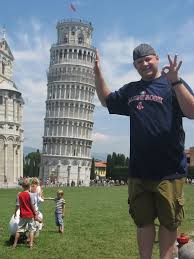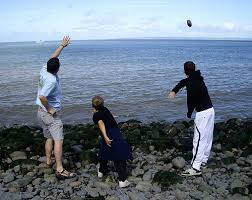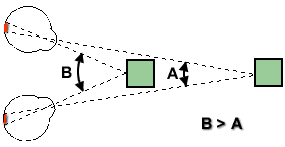Repeated practice and exercise facilitate adequate development of outer layer of consciousness. Dutta Roy (2006) has noted poor development of outer layer among the tribal children living in the hills of Tripura. They were not exposed to training on drawing.
ILLUSION: Illusions are misperceptions resulting from misinterpretation of sensory information. Illusions are also known as false perceptions.
Muller-Lyer illusion: The Muller-Lyer illusion is one of the most famous of illusions. It was created by German psychiatrist Franz Muller-Lyer in 1889.It is a geometric illusion in which two lines of equal length appear unequal depending on whether angular lines forming arrowheads at each end point toward or away from each other. The Müller-Lyer illusion is based on the Gestalt principles of convergence and divergence: the lines at the sides seem to lead the eye either inward or outward to create a false impression of length.
Perception of distance and depth: Perception of space also refers to the perception of size and distance. The problem emerges from the fact that the image of the three dimensional world is projected on the two dimensional retina. This raises the question: From the two dimensional image, how do we perceive the three dimensional world? Distance perception is based on set of monocular and binocular cues.
Monocular cues: Monocular cues provide depth information when viewing a scene with one eye.
Monocular cues: Monocular cues provide depth information when viewing a scene with one eye.
Motion parallax
When an observer moves, the apparent relative motion of several stationary objects against a background gives hints about their relative distance. Nearby things pass quickly, while far off objects appear stationary.
Monocular Cues are also called pictorial cues because they include the kind of
depth information found in the photographs and paintings. These cues are extensively
used by the artists in their paintings. These cues are
a. Interposition
b. Aerial perspective
c. Linear perspective
d. Lights and Shadows
e. Familiar size
f. Texture-Density Gradient
Let us consider these cues briefly.
(a) Interposition: When an object (A) partially blocks another object (B), the
object blocked is perceived farther away than the object blocking it (See Fig.
5.10). This cue develops early in the children.

(b) Aerial perspective: When you look at buildings in the city, buildings close
by look clearer and their boundaries (contours) are well defined in comparison
to distant ones, which look gray and hazy. The buildings, trees, and other
objects that look hazy are perceived far away in comparison to those which
look clear.

(c) Linear Perspective: When parallel lines recede into the distance, as rail
road tracks, they converge towards a point in your retinal image. Further, the farther away two objects are in the visual field, the closer they will appear to be to each other. On the other hand, the two objects nearer to us appear further apart from each other. This cue appears much later in children.

(d) Lights and Shadows : We are often aware of the source and direction of
light. It is generally from above, as sunlight. The shadows cast by one object
on another can indicate which object is farther away.

(e) Familiar Size: Because you know the height of your friend, you can judge
the distance at which he is standing. This is possible because we always store
the memory image of objects that we see. When we look at an object which
is away from us we can interpret the distance form the retinal image by taking
into account the familiar size. You can do this activity. Take a playing card and
present it to your friend at a distance of 10 ft from him. Ask him to judge the
distance at which the card is placed. He will be quite accurate in judging the
size of the playing card. Because he is familiar with the size of the card, which
is always of the same (standard) size.

(f) Texture-Density Gradient : Look at the ploughed field, the nearer surface
looks rough and as we extend our vision farther away the texture gets finer.
Similarly, if you look at the grass nearby, you will be able to see the blades of
grass clearly, but as you extend your vision to a distant point the ground looks
as if painted green and the blades of the grass are no more visible. This texture
gradient is a cue to distance. The objects lying on a surface that look fine and
smooth in texture are perceived at greater distance than those objects on a
rough surface.

Eye cues
a. Accommodation: The image of the external objects is focused on the retina with
the help of lens in the eye. The lens is adjusted by the Ciliary muscles to focus
far and near objects on the retina. The ciliary muscle changes the convexity of the lens so that the image of the object is clearly focused and this process is called accommodation. If the object is relatively at a distance (more than 2 meters or so) the ciliary muscle is relaxed. When the object comes nearer and nearer the muscle contracts more and more, making the lens more convex. The degree of contraction of the ciliary muscle, signaled to the brain through Kinesthetic impulses is a possible cue of distance. That is, if the object is farther away from the viewer, the ciliary muscle is relaxed and when the object is nearer the ciliary muscle is tense. The extent of contraction in the ciliary muscle fed back to the brain is the cue of accommodation.

b. Convergence: When you read the letters of this printed line, you converge
your eyes (with the help of six intra-ocular muscles located outside each eye)
to bring the image in both eyes to fall on the fovea of each eye for fusion and
clear vision. The extent of convergence achieved is signaled to the brain and this
provides a cue to distance. For example, if the object is nearer the angle of
convergence will be large and as the object goes farther away the angle of
convergence decreases. For objects at a far away distance the eyes are more or
less parallel. The extent of convergence achieved is fed back to the brain and it is a cue to distance.
(ii) Binocular Cues : These cues are:
a. Double images
b. Binocular disparity
a. Double images: You have already learnt that when we fixate our eyes on an
object in space, fusion takes place and we see one object. However, when we
fixate on an object, all other objects nearer or farther than the fixation point fall on the non-corresponding points and produce double images.You can try this phenomenon. Take two pencils, hold them vertically in a line in front of your nose, one nearer and the other farther away. Now, fixate your eyes on the nearer pencil, the image of this pencil falls on the corresponding points.
FACTORS INFLUENCING PERCEPTION
At any particular time there are many competing stimuli out there which will gain
our attention and result in perceptual organization. The stimulus characteristics are important, as are our own internal needs, motivations, and our specific sociocultural back ground in which we have been reared. All these factors, stimulus variables and internal factors peculiar to an individual, determine how our perceptions are organized. In the following section you will learn how the stimulus and internal factors determine what we perceiv
i. Context and Set-effects
ii. Needs and motives
iii. Social and Cultural factors.
i. Context and Set-effects
A given stimulus may provide radically different perceptions because of the
immediate context. The context creates an expectation in our brain (top-down
phenomenon) that influences our perception at a particular moment. For example,
in noisy conditions you are verbally provided with a sentence “eel is moving”. You
will perceive the word “eel” as "wheel" because of the context provided by the
later part of the sentence. Similarly provide a stimulus verbally “eel the orange”. You will perceive the word “eel” as peel. This is because the later word “orange” provides an expectation for the perception of earlier word.
Perceptual sets also influence our perceptions. Perceptual set refers to our mental expectancies and predispositions to perceive one thing and not another. Perceptual set can influence what we hear as well as what we see. Broadly speaking our educational, social, and cultural experiences shape what we perceive. In other
words, our learned assumptions and beliefs help us in organizing our perceptions.
For example, if we hold very strong beliefs about God, the temple is perceived as
a place that gives us peace, love, solace, affection, and a satisfying experience.
Similarly, stereotypes (a generalized belief about a group of people) help us to
perceive persons we meet first time. Much of our social interaction is determined
by the stereotypes we hold about individuals and groups.
(iii) Needs and Motives
We have seen above that immediate Context and perceptual sets affect our
perceptions. Similarly, personal variables, like needs, emotions, values, personality,etc. influence our perceptions. An example will demonstrate the effect of need state on the perception of an individual. Two men, a hungry and another thirsty, go to a restaurant and the waiter hands over to each a menu for obtaining order. It was found that, at a quick glance, the hungry man could see eatable items in the menu and the thirsty drinks. This example supports the hypothesis that need states of individuals affect their perceptions. It has been found that emotions, motivation, and personality factors influence our perceptions. For instance, while studying the effect of reward and punishment on the organization of one’s perception, it was found that children perceived significantly more often rewarded aspects of the figure-ground stimuli in comparison to the punished.
(iii) Social and Cultural factors
Perceptual learning and development takes place in the context of socio-cultural
environment. Our perceptions reflect the effect of past learning and, therefore, if learning and socialization takes place in a particular socio-cultural background it will be reflected in our perceptions. A large number of studies support the hypothesis that culture influences our perceptions. It has been found that the Africans living in dense forests displayed greater illusion in the Vertical – Horizontal figure and Western-Urbans in the Muller –Lyer figures. The differences have been explained due to their experiences in different culture. So, it should be clear to you that cultural background influence the individual to perceive the world differently.

No comments:
Post a Comment